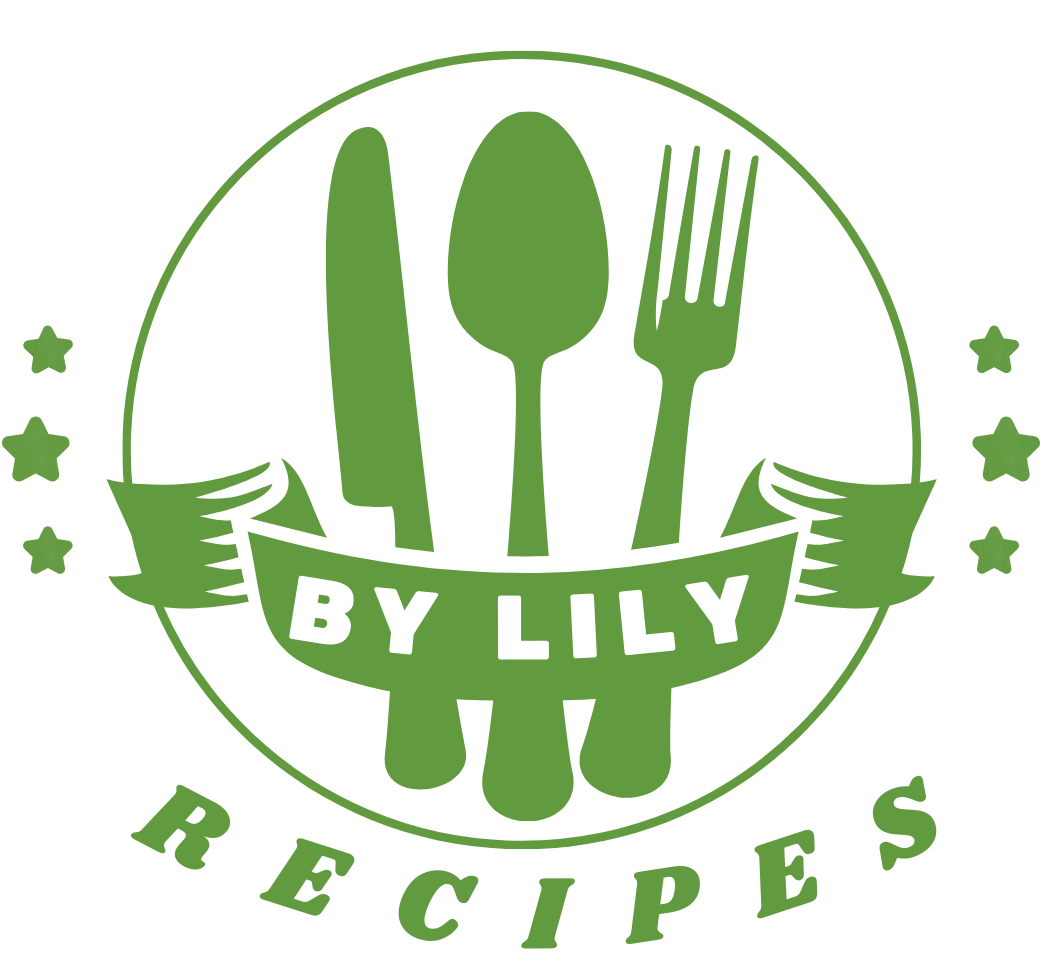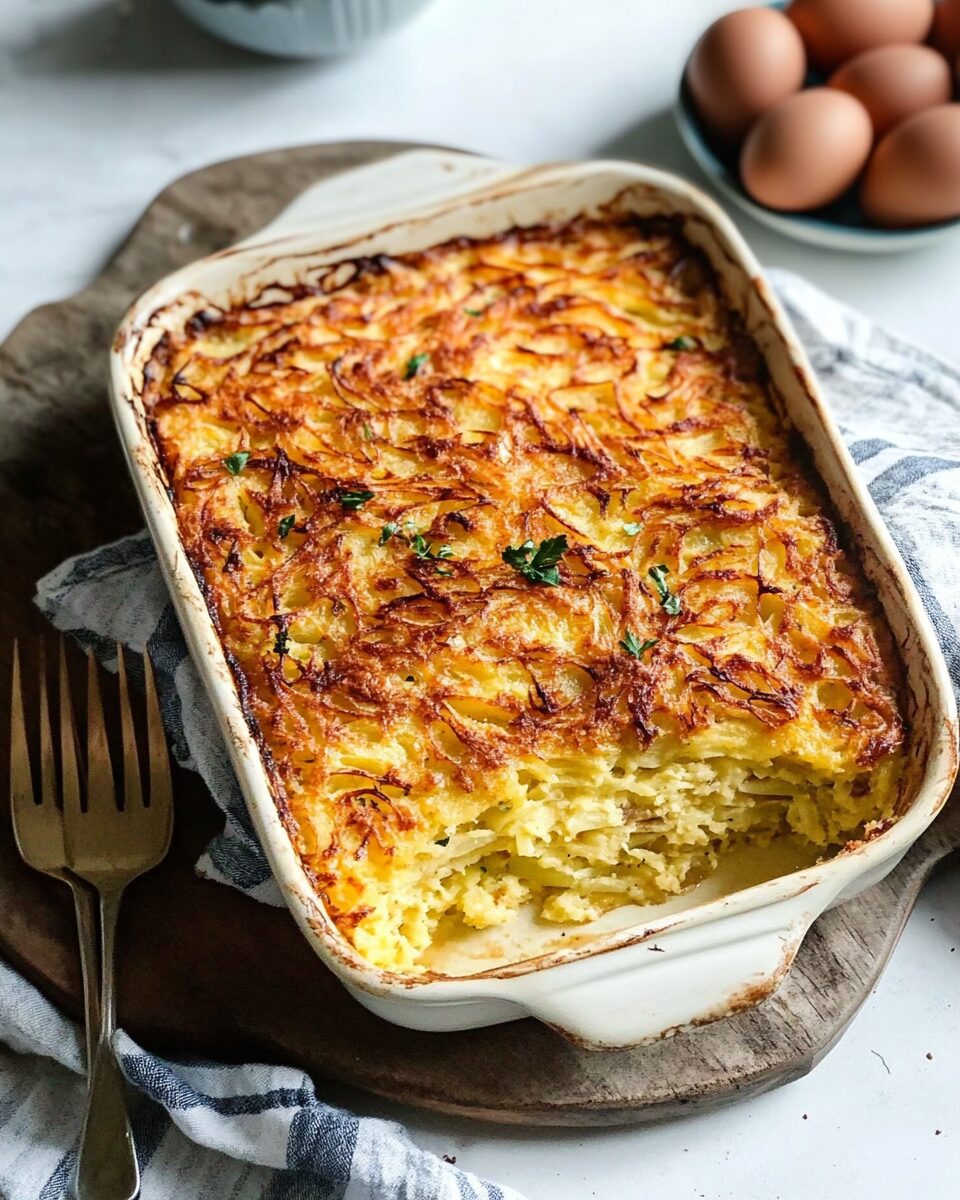Why This Recipe Works
Potato kugel is both simple and brilliant. It begins with russet potatoes, which are high in starch and ideal for creating both fluffiness and crisp edges. The technique of soaking the grated potatoes in ice water and then squeezing them dry removes excess starch and moisture, preventing sogginess and encouraging that signature crispy crust.
Grated onion adds sweetness and depth, while eggs and potato starch help bind everything together into a cohesive bake. The use of matzo meal (or flour) adds structure, and olive oil not only enhances flavor but also plays a crucial role in browning and crisping the top and bottom layers.
Baking the kugel in a preheated dish with hot oil ensures the edges sizzle as soon as the mixture hits the pan. This mimics the searing of latkes and guarantees a crunchy, caramelized crust.
The addition of parsley brings color and freshness, and the minimal seasoning lets the natural earthy-sweetness of potatoes and onions shine. It’s an example of how thoughtful technique and quality ingredients can elevate a humble dish into a treasured comfort food.
Flavor and Texture Highlights
Potato Kugel has a rich, savory flavor profile centered around the sweetness of caramelized onions and the earthy, creamy character of well-baked potatoes. The crispy top and bottom contrast beautifully with the soft, almost custard-like center. A hint of fresh parsley brightens the dish, while generous seasoning with salt and pepper balances its depth.
Each bite combines tender strands of potato with golden, crackling crust. It’s this contrast in textures—crunchy and fluffy—that makes kugel more than just a side dish. It becomes the kind of food that people go back for second (or third) helpings of, whether they’re observing a holiday or just enjoying a cozy dinner.
Cultural and Historical Significance
Potato kugel is rooted in Eastern European Jewish culinary tradition, where resourcefulness and heartiness were essential in daily cooking. It became especially popular as a Sabbath and holiday food because it could be prepared in advance, served hot or warm, and easily feed a crowd. During Passover, kugel adapts to dietary laws by replacing flour with matzo meal and avoiding dairy.
Its appeal has crossed generations and regions, evolving with family customs and local ingredients. While noodle kugels and sweet varieties exist, savory potato kugel remains the most iconic version—a reliable, filling, and crowd-pleasing dish for Jewish families around the world.
Nutritional Highlights
Potato kugel delivers a balance of carbohydrates, fats, and proteins that makes it deeply satisfying. One serving (from a 9×13-inch pan that serves 8 to 10) offers approximately 339 calories, 11 grams of fat, and 10 grams of protein, making it hearty enough to serve as a main or a substantial side.
The use of olive oil provides heart-healthy fats, while potatoes supply dietary fiber (5g per serving), potassium (24% DV), and vitamin C (101% DV). Eggs add richness and essential nutrients like choline and vitamin B12.
This dish is naturally gluten-free when using matzo meal, and dairy-free, making it suitable for those with common food restrictions. You can also substitute with gluten-free flour blends outside of Passover for similar results.
Tips for Best Results
Use a food processor with a shredding blade for faster prep and more consistent texture, especially when making large batches.
Soak the grated potatoes in ice water to prevent browning and help create a lighter texture. Drying them thoroughly before mixing ensures the kugel crisps properly.
Use a heavy glass or ceramic baking dish that retains heat well for even baking and browning. Preheating the dish with oil is essential—it sears the bottom and edges on contact, creating that unmistakable crust.
Don’t skip the potato starch, as it acts as a binding agent and improves texture without altering the flavor.
Let the kugel rest for a few minutes after baking so it slices cleanly. For extra crispiness, reheat slices in a hot skillet or under the broiler the next day.
Serving Suggestions
Potato kugel is a versatile dish that pairs with many traditional and modern accompaniments. It shines on the table with:
Roast chicken, brisket, or roast beef for a complete, satisfying meal
Braised greens, sautéed cabbage, or a simple cucumber salad for freshness
Sour pickles, applesauce, or horseradish for contrast
It’s also delicious as a vegetarian main alongside a green salad or lentil soup.
Serve hot for best texture, though it’s equally delicious at room temperature—making it ideal for buffets, potlucks, and Shabbat meals.
Make-Ahead and Storage Tips
Potato kugel can be made a day ahead and stored, covered, in the refrigerator. Reheat in a 350°F oven for 20–30 minutes until warmed through and crisp on top.
Leftovers will keep for up to 4 days in the fridge and freeze well. Wrap slices individually and store in an airtight container. Reheat from frozen in the oven or toaster oven for best results.
You can also bake the kugel fully, let it cool, and slice it in advance for easy serving during busy holidays.
Why You’ll Love This Recipe
This classic potato kugel is rich in flavor, simple to make, and universally comforting. It’s a dish that invites tradition while leaving room for customization. Whether you grew up eating kugel every Friday night or are new to Ashkenazi cooking, this version is a reliable crowd-pleaser.
Its satisfying texture, golden crust, and naturally allergen-friendly ingredients make it accessible for a variety of dietary needs. Plus, it’s an ideal “make-ahead” dish that holds up beautifully—perfect for holiday planning and family gatherings.
Conclusion
Potato Kugel is a celebration of tradition, comfort, and simplicity. Its crispy, golden crust and soft, seasoned interior make it a timeless favorite at Jewish holiday tables—and a delicious option any time you crave something hearty and wholesome. Whether you’re cooking for Passover, a potluck, or a cozy family dinner, this kugel delivers warmth, flavor, and a strong sense of culinary heritage. From its humble ingredients to its rich texture and aroma, every bite tells a story of home.






